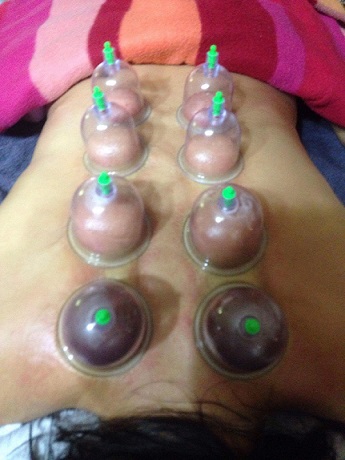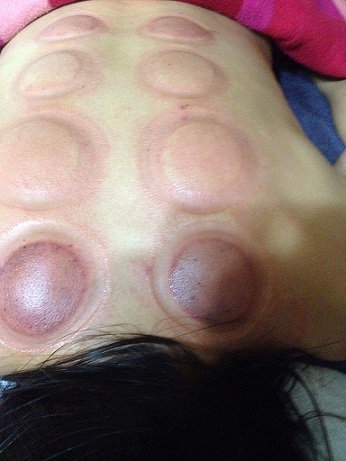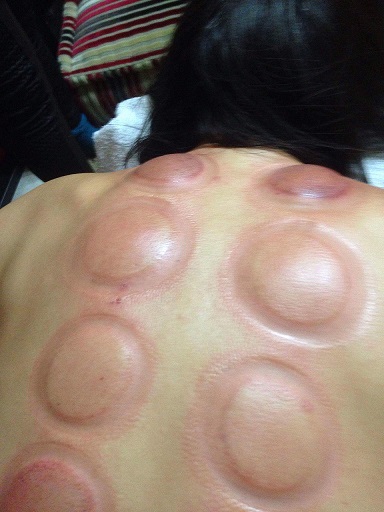Cupping therapy is an ancient healing method based on the application of heated glass on the skin. In prehistoric times, people developed the art of sucking by mouth or pulling irritants, poisons and thorns by teeth.
In their attempt to find an explanation behind the existence of health and disease, they developed systems in which the disease and the pain were due to “evil spirits” which penetrated the body. Anthropologists have discovered several practices in which therapists sucked by mouth so that these spirits would leave the body.
Gradually methods and tools were developed, to facilitate more efficient absorption. In the Assyro – Babylonian empire and later in Europe, Asia and North America a hollow animal horn was used on the affected area. The air was sucked out of the broken top of the horn, which was then sealed with chewed grass.

In ancient Greece, cups are portrayed in the performances of Telesphoros. Telesphoros was a god and follower of Asclepius.Metal and usually bronze cups have been found in tombs of the Roman period in medical cases. A tool named “spathomili” which was used for marking the skin, has also been found.There are suction cup illustrations on ancient coins from Amorgos. Another well-known representation is the headstone of Jason Kaidekmou, a doctor from Acharnes, which portrays him sitting and taking care of a young patient, while cups are next to him.
Nikandros in “Thiriaka” reports that cups should be placed on a snake’s bite, in order to pull the poison out and he suggests the using of copper cups. That means they used cups made of many other materials. Aretaeus also mentioned many times the use of cups for the treatment of depression and headache. Oribasius in the “Summary” mentions that cupping should not be applied in the beginning of an illness or near the breast.
Other sources mention that cups were made from animal horns in addition to metal ,clay or glass ones. Galen says that they had a hole at the top. In ancient times, there were even vegetable cups. They were made from the fruit of the plant cucurbita lagenaria. Aristotle mentions that in “The history of the animals.”
In the texts of Hippocrates, we find the first written references to cups. Hippocrates proposed that cups should be small in diameter, conical in shape and light, even if the disease they were intended for was deeply rooted. cupping remained a basic therapeutic tool in Europe.Many famous physicians such as Paracelsus (1493-1541) and Ambroise Pare (1509-1590) used them.
In the 19th century, cupping therapy received harsh criticism from the medical community, but in recent decades, opinions have been changed.

In Greece, cupping therapy is widespread, especially in the villages, as a basic treatment of colds and flu. The cups are small or large glasses, which are heated. Fire cupping involves soaking a cotton ball in almost pure alcohol. The cotton is clamped by a pair of forceps and lit via match or lighter, and, in one motion, placed into the cup and quickly removed, while the cup is placed on the skin. Fire heats the inside of the cup and a small amount of suction is created by the air, cooling down again and contracting. Massage oil, may be applied to create a better seal as well as allow the cups to glide over muscle groups (e.g. trapezius, erectors, latissimus dorsi, etc.) in an act called “moving cupping”. Dark circles may appear where cups have been applied,because of the rupture of the capillaries just under the skin.
Cupping is a technique used in conjunction with acupuncture or dry needling. Cupping pulls blood to a region to stimulate healing. It is effective for stretching tight fascia and muscles. Cupping helps tissue develop new blood flow and causes anti-inflammatory chemicals in the body. According to traditional Chinese medicine (TCM) cupping is a method of creating a vacuum on the patient’s skin to dispel stagnation — stagnant blood and lymph, thereby improving Qi flow — to treat respiratory diseases such as the common cold, pneumonia and bronchitis.
Cupping therapy is not recommended for individuals who suffer from fainting spells, in cases of high fever, severe cramps, allergic skin reactions, ulcers in areas with very thin skin, breasts, the belly and waist area during pregnancy, over the heart, or the main human blood vessels. Finally cupping is contraindicated in extreme energy shortage conditions.
Caution: Do not attempt to use cups on someone if you do not know how to perform or accept cupping therapy from someone you do not trust, because there is a risk to health. In children and weak adults and the elderly leave the suction cup up to five minutes so as not to spend their Qi. Minors can keep them for between 10 and 25 to 30 minutes depending on the energy and power of the pathogen. A strong adult with excess state may need strong suction cups for 20-30 minutes. suction cups can be used on the average Western human up to 2-3 times a week.

The cups can be of various shapes including balls or bells, and may range in size from 1 to 3 inches (25 to 76 mm) across at their opening. Plastic and glass are the most common materials used today, replacing horn, pottery, bronze and bamboo cups used in earlier times. The low air pressure required may be created by heating the cup or the air inside it, with an open flame or a bath in hot scented oils, then placing it against the skin. As the air inside the cup cools, it contracts and draws the skin slightly inside. More recently the vacuum is created through a mechanical suction pump operating through a valve located at the top of the cup. Rubber cups which squeeze the air out and adapt to uneven or bony surfaces are also available.
According to traditional Chinese medicine (TCM), cupping is the method of creating a vacuum on the patient’s skin to dispel stagnation (stagnant blood and lymph), thereby improving QI flow, in order to treat respiratory diseases such as the common cold, pneumonia and bronchitis. Cupping is also used on the back, neck, shoulder and for other musculoskeletal conditions. Its advocates claim it has other applications as well. TCM does not allow Cupping over skin ulcers or on the abdominal or sacral regions of pregnant women. Massage cupping is a massage technique based on cups. Creating vacuum and negative pressure massage helps drastically. It stimulates the peripheral nervous system, restores the free flow of blood and energy to the muscles and skin and solves adhesions in connective and soft tissue of the body. Massage can mainly be applied to the neck, shoulders, back, waist, in the sacral region, buttocks, the abdominal area, thighs, arms… Apply an anti-bruising cream or cabbage juice before you massage.
suction cups in Hollywood … Victoria Beckham introduced them and Gwyneth Paltrow followed. The star of the TV serial “Girl”, Lena Dunums, did not hesitate to post her bruised back on instagram.
Varvara Solomonidou,Wellness Specialist, Personal Trainer, Seminar & Conference Lecturer, Pilates Master Trainer “AthensTrainers® Ultimate Pilates System®”, General Manager & Owner of AthensTrainers®\

Sources:
www.therapy.gr
www.nea-acropoli-athens.gr
www.acupuncture.com.cy
www.faysbook.gr